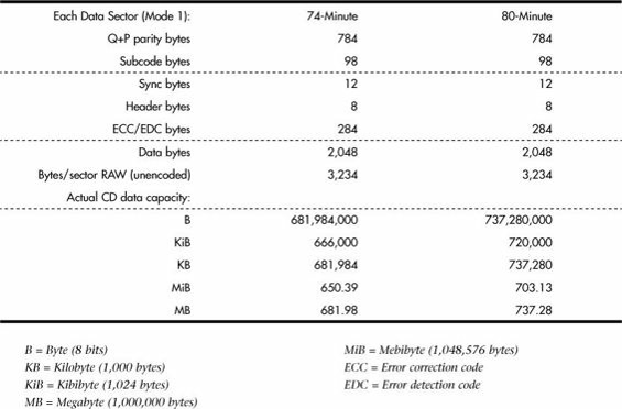Hardware Reference
In-Depth Information
This information assumes the data is stored in Mode 1 format, which is used on virtually all data
discs. You can learn more about the Mode 1/Mode 2 formats in the section on the Yellow Book and
XA standards later in this chapter.
With data sectors, you can see that out of 3,234 actual bytes per sector, only 2,048 are user data. Most
of the other 1,186 bytes are used for the intensive error-detection and -correction schemes to ensure
error-free performance.
Data Encoding on the Disc
The final part of how data is actually written to the CD is very interesting. After all 98 frames are
composed for a sector (whether audio or data), the information is then run through a final encoding
process called
eight to fourteen modulation
(EFM). This scheme takes each byte (8 bits) and
converts it into a 14-bit value for storage. The 14-bit conversion codes are designed so that there are
never fewer than two or more than ten adjacent 0 bits. This is a form of Run Length Limited (RLL)
encoding called RLL 2,10 (RLL x,y, where x equals the minimum and y equals the maximum run of
0s). This is designed to prevent long strings of 0s, which could more easily be misread, as well as to
limit the minimum and maximum frequency of transitions actually placed on the recording media.
With as few as two or as many as ten 0 bits separating 1 bits in the recording, the minimum distance
between 1s is 3 bit time intervals (usually referred to as 3T), and the maximum spacing between 1s is
11 time intervals (11T).
Because some of the EFM codes start and end with a 1 or more than five 0s, three additional bits
called
merge bits
are added between each 14-bit EFM value written to the disc. The merge bits
usually are 0s but might contain a 1 if necessary to break a long string of adjacent 0s formed by the
adjacent 14-bit EFM values. In addition to the now 17 bits created for each byte (EFM plus merge
bits), a 24-bit sync word (plus three more merge bits) is added to the beginning of each frame. This
results in a total of 588 bits (73.5 bytes) actually being stored on the disc for each frame. Multiply
this for 98 frames per sector and you have 7,203 bytes actually being stored on the disc to represent
each sector. An 80-minute disc, therefore, really has something like 2.6GB of actual data being
written, which, after being fully decoded and stripped of error-correcting codes and other

